Media | Articles
11 Mustangs that never came to be
The Ford Mustang’s path from affordable coupe to performance icon has taken many twists and turns in its nearly 60-year history. Built on a platform similar to that of Ford’s econo-oriented Falcon when it was first introduced as a mid-year model in 1964, the Mustang pulled much of its styling inspiration from the Allegro concept that had appeared the year before, and its formula of small car plus V-8 engine would set the tone for the next six decades of its existence.
At least, that’s what happened in our timeline. The alternate history of the Ford Mustang—the one that never came to be—shot off in all sorts of weird and wonderful directions, buffeted by the winds of market change, the addled dreams of designers chasing the latest trends, and the vagaries of engineers dazzled by the latest technologies.
Check out these Mustangs that might have been, but never were.
The sedan
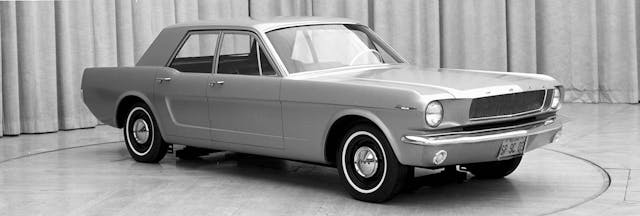
Two early “what if” branches of the family tree illustrated what the Mustang lineup could have looked like had it expanded into a more complete portfolio of cars. Instead, it aimed at satisfying performance fans later and those seeking an inexpensive commuter early on.
The wagon
While the four-door Mustang sedan concept, built in 1965, never made it anywhere past the designer’s studio, a two-door wagon (or shooting brake) version of the car had much longer legs. The fevered dream of three Ford fans—including Robert Cumberford (designer), Barney Clark (Blue Oval ad exec), and Jim Licata (partner in crime)—the cargo-friendly Mustang was converted from a coupe that had been sent to Italy’s Costruzione Automobili Intermeccanica that same year.
Marketplace
Buy and sell classics with confidence
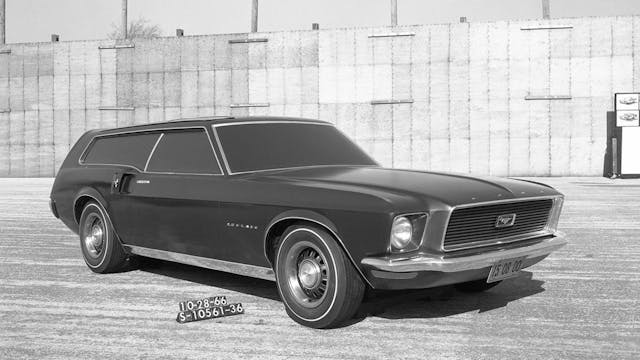
When the finished product came back, the trio took it to Ford, Holman Moody, and even independent automotive production companies, all of whom passed on putting it into production. While the original is lost to the mists of time, a number of individuals and aftermarket companies have produced their own Mustang wagon replicas based on its design, giving us a glimpse back at a history that never happened for a car that never officially existed.
Mustang II: A bigger Maverick?
It’s interesting that the most lamented member of the Mustang fold was also the one that underwent such a far-ranging design process before being birthed into the world.
By the early ’70s it was clear that Ford would have to make some choices about the future of the coupe, given impending EPA regulations about fuel economy, the precarious world energy situation, and changing crash-test regulations. This meant a crossroads for the Mustang, and some incredibly out-there looks at what the next-generation Mustang II could be.
Initially, Ford tried to retain the car’s original platform and give it a much longer, personal-luxury type of design, but it became clear that wouldn’t work. A second swipe at the O.G. platform produced something that looked more like an enlarged Maverick than it did a Mustang.

Two crucial interventions in the Mustang II process led the company to the eventual production car: a decision to shrink the coupe’s wheelbase (and work a partnership with Ghia).
Ghia’s nose jobs
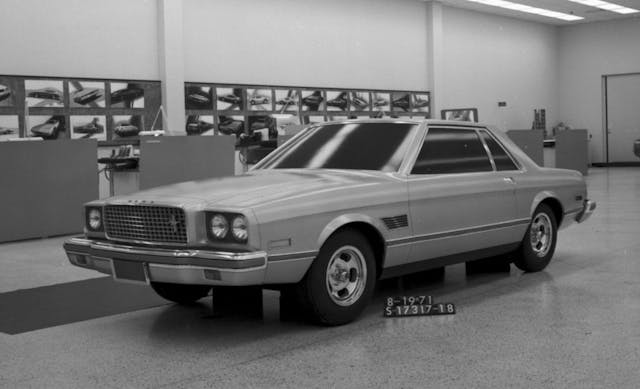
By 1971, Ford was producing Mustang concepts at a startling rate. At first, the smaller Ghia-assisted prototypes still embodied the upright, premium coupe look that had been seen on the larger models, both with a shark-nosed element that was clearly European, and without, in a style that would be seen later on vehicles like the Granada.
Japanese-esque hatch
Where things really got interesting was when the Ghia studio jumped well outside the box of the decade’s styling trends and offered a hatchback version of the Mustang II that, seen in hindsight, could easily have leapt forth from the production lines of a Japanese manufacturer like Datsun or Mitsubishi in the early ’80s. Arguably, this is a far cleaner design than the actual production Mustang II, but it’s difficult to project how a look that was so far ahead of its time would have been received by a market that was still staggering out of the muscle car era.
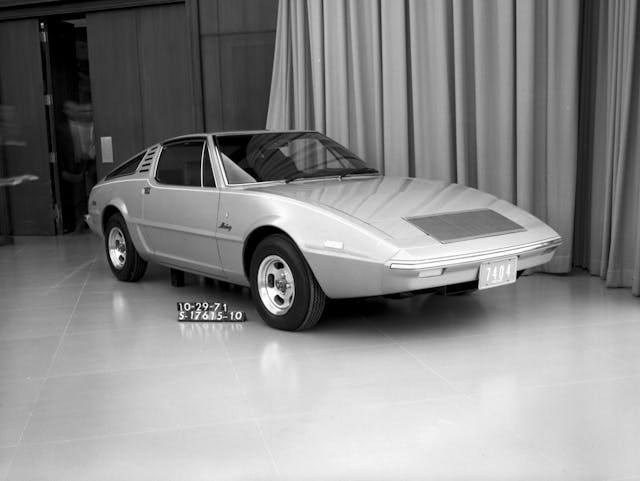
The Probe that almost became a pony
Ghia’s prescient hatch was a harbinger of the existential crisis that would strike the Mustang in the mid-’80s. Swamped by strong-selling imports, and convinced that the market for traditional, rear-wheel-drive, V-8 coupes was about to drop off a cliff, Ford partnered with Mazda to produce the anti-Mustang, which was dubbed the SN-16.
Although the styling never moved past this clay model (which displays the grille-mounted pony logo running in the opposite direction, presumably as a sign of distress), engineering teams were hard at work on a new platform for the car, and by the time testing began in 1987, FoMoCo fans were up in arms about the proposed drive-wheel switch for the Mustang and mounted a letter-writing campaign that deep-sixed the idea.
If this front-wheel-drive jelly bean looks familiar, however, that’s because it would eventually find its way to the market as the Ford Probe in 1988, a coupe that never really resonated with the performance crowd (and which was kissing cousin to the Mazda MX-6).
Three action heroes, one rescued icon
It’s no surprise that Ford’s sudden about-face seriously impacted the development of the Mustang’s replacement. Initially, the company simply continued to sell the Fox-platform car alongside the Probe, delaying its replacement in part because the front-wheel-drive experiment had soaked up so many development dollars. Not only that, but the Blue Oval continued to dump cash into front-wheel-drive pony car development at the same time as it pursued a new, rear-wheel-drive platform for the Mustang because it was unwilling to simply walk away from the sunk cost.
By 1990 it became clear that an eight-cylinder, front-wheel-drive Mustang was a non-starter, but by that time there wasn’t much cash left in the coffers to get truly radical with the vehicle’s styling or chassis. The end result was the SN95 platform, also known as Fox-4, which simply updated aspects of the original Fox and allowed for the eventual inclusion of Ford’s modular 4.6-liter V-8.

A reheated Fox might have spelled disaster for the Mustang if it not for the idea of latching on to heritage elements from the original design and baking them in to the new model. One of the first of the modern retro cars that would come to define a certain slice of ’90s automotive styling, the SN95 Mustang’s potential looks were whittled down to three contenders, each named after a popular action star of the day,
The “Bruce Jenner” design clearly displays elements that would go on to eventual production in both the Ford Contour and redesigned Ford Taurus sedans, but its smooth lines were considered too soft for the Mustang.
The “Rambo” was a much more aggressive liftback design that seemingly shared its inspiration with GM’s radically redesigned F-body Camaros and Firebirds that would also debut around the same time. It was seen as more extroverted than what Mustang fans would accept.
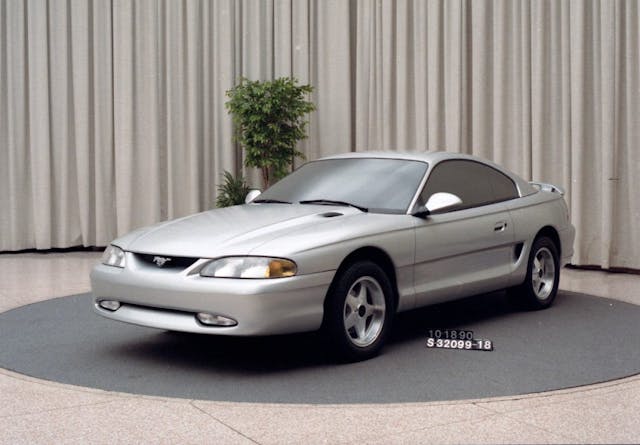
The “Schwarzenegger” was the model that would eventually find its way into production, a car that featured the familiar, large side scallops that evoked the original Mustang design, as well as the long hood and short rear deck evocative of the early coupes. It was this look that would lead to a dramatic surge in sales for the pony car and once again make it relevant in the world of both performance and style.
Two other intriguing silhouette sketches of the fourth-generation Mustang also show how designers of the same era share much of the same mental real estate when exploring potential concepts. One features inspiration drawn from the Mercedes-Benz SL-Class coupe, while the other depicts a startling prediction of what Dodge’s upcoming Avenger would look like a few years down the road.
Interestingly, a combination of the Rambo and the Schwarzenegger designs was also built, and it’s hard not to look at it without seeing the face of the Oldsmobile Alero that would hit the streets less than a decade later. Woof.
Check out the Hagerty Media homepage so you don’t miss a single story, or better yet, bookmark us.








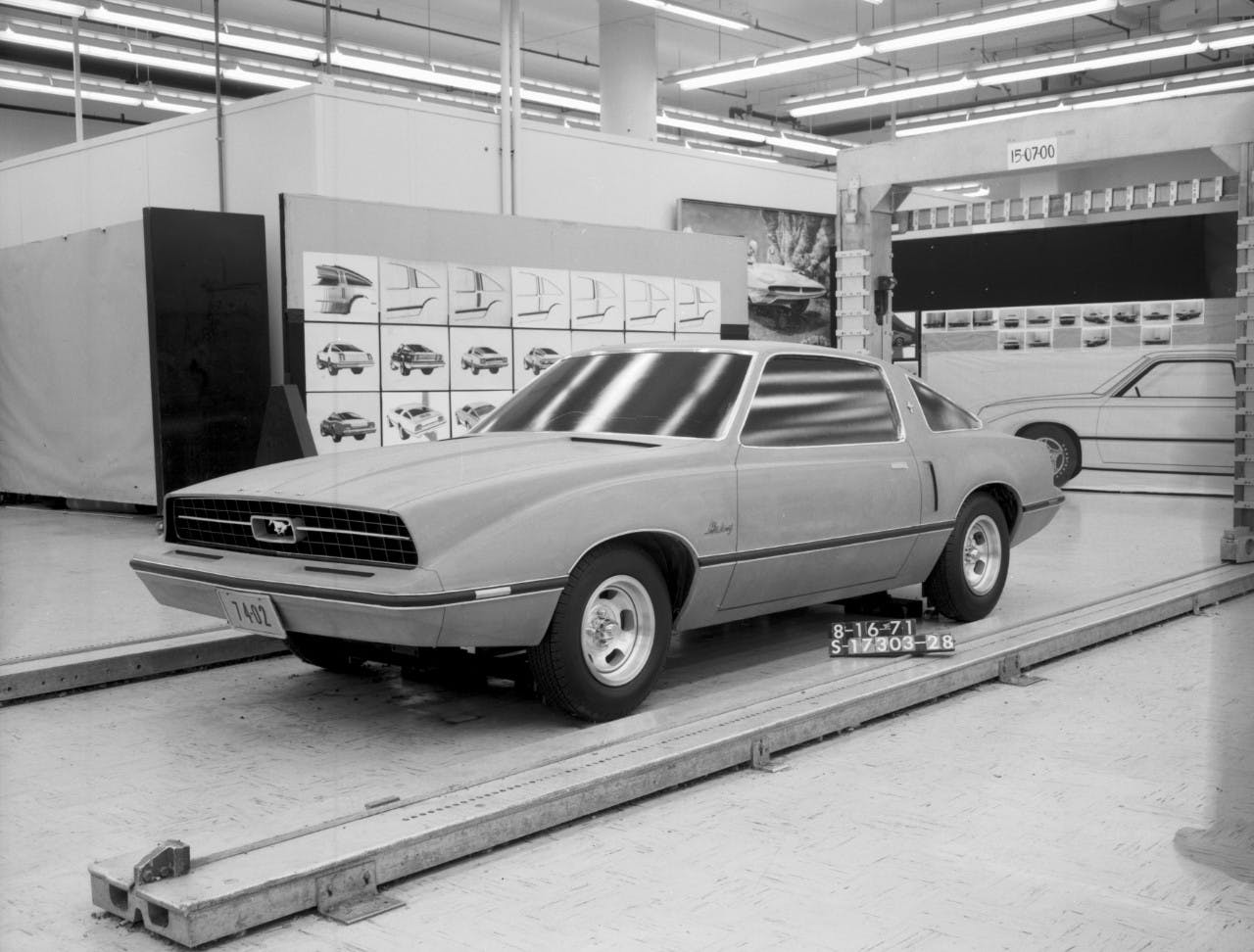
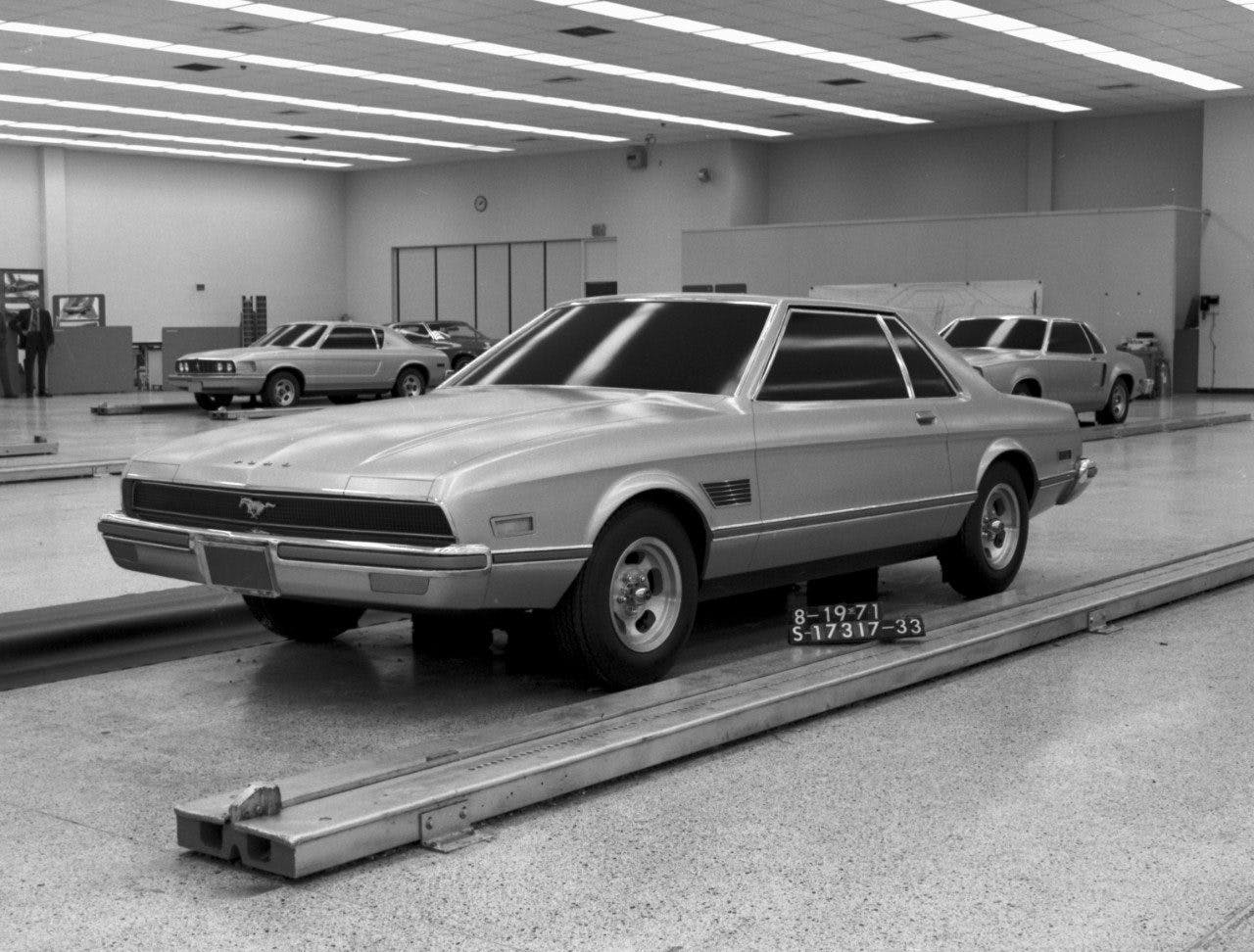
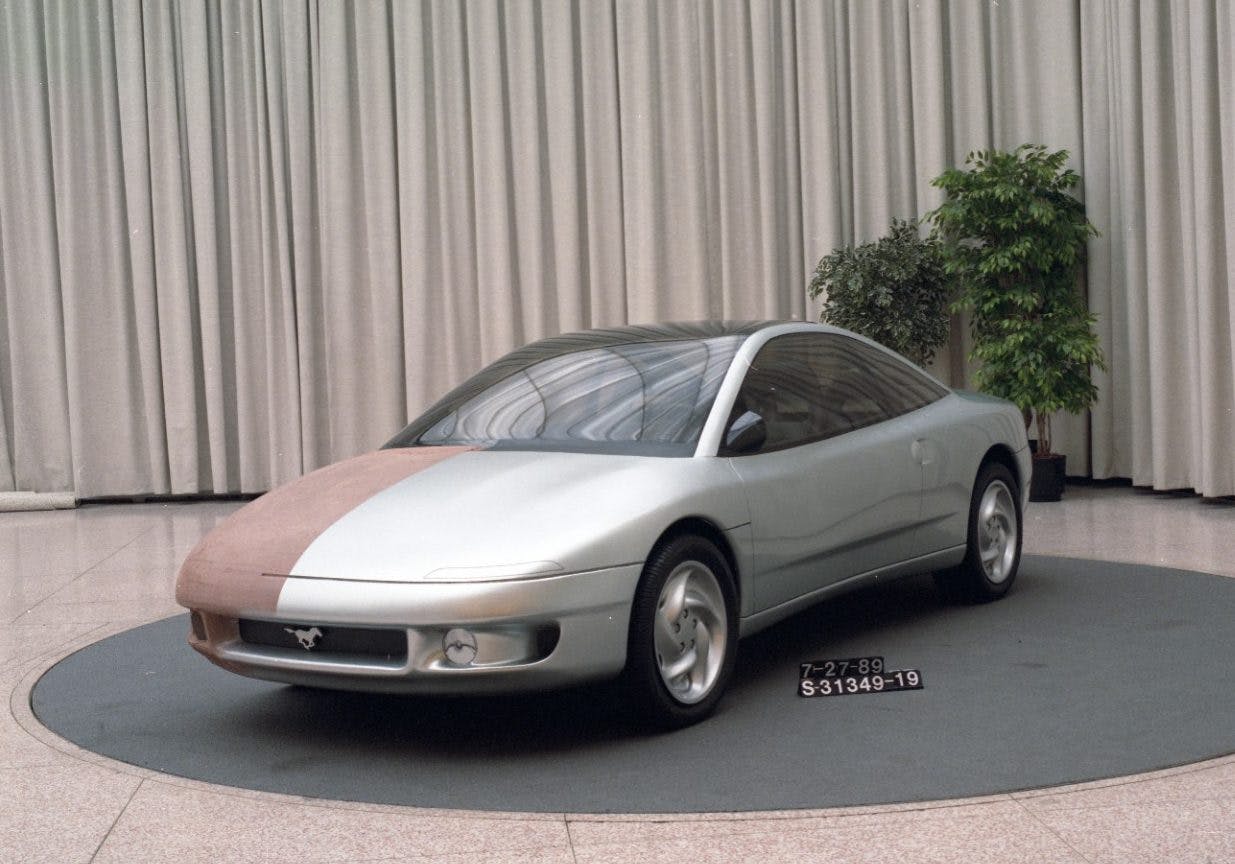
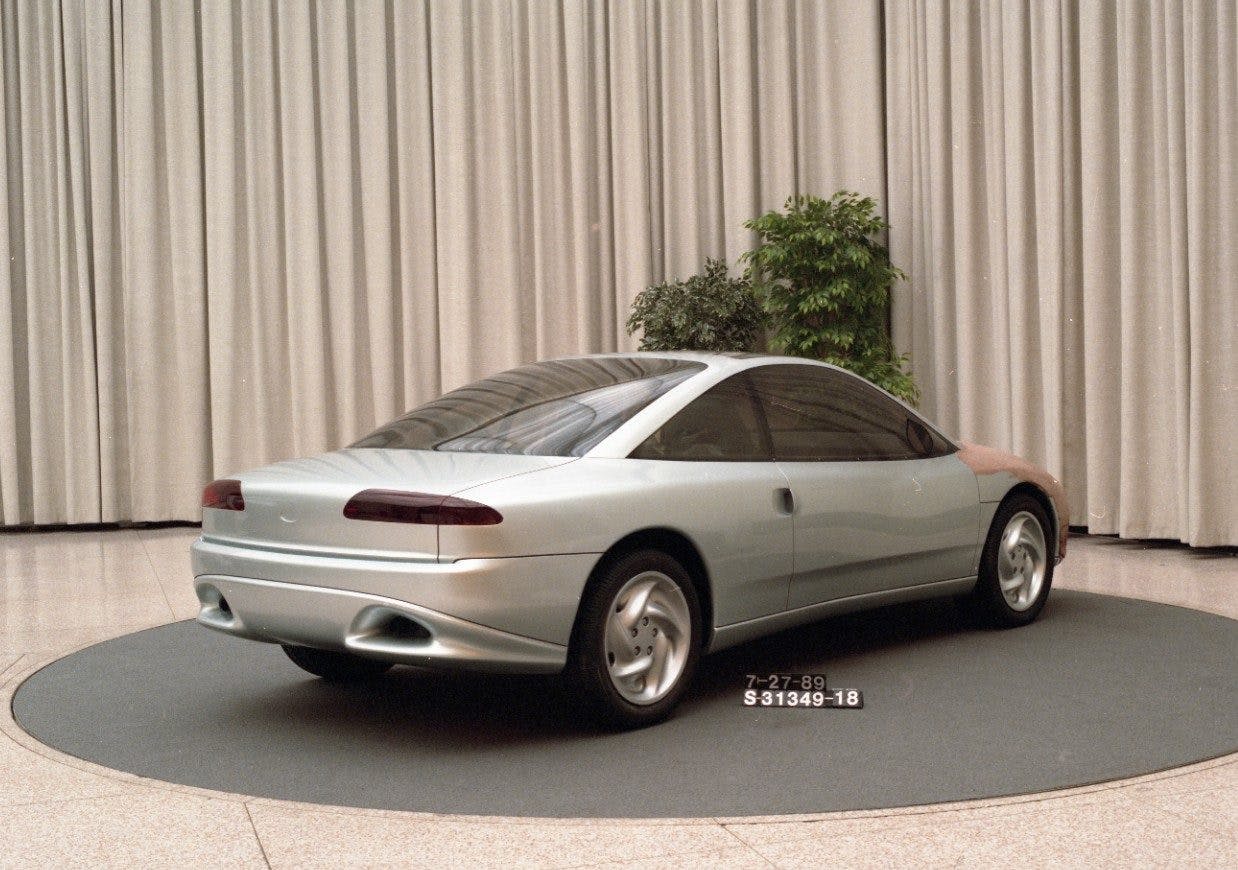
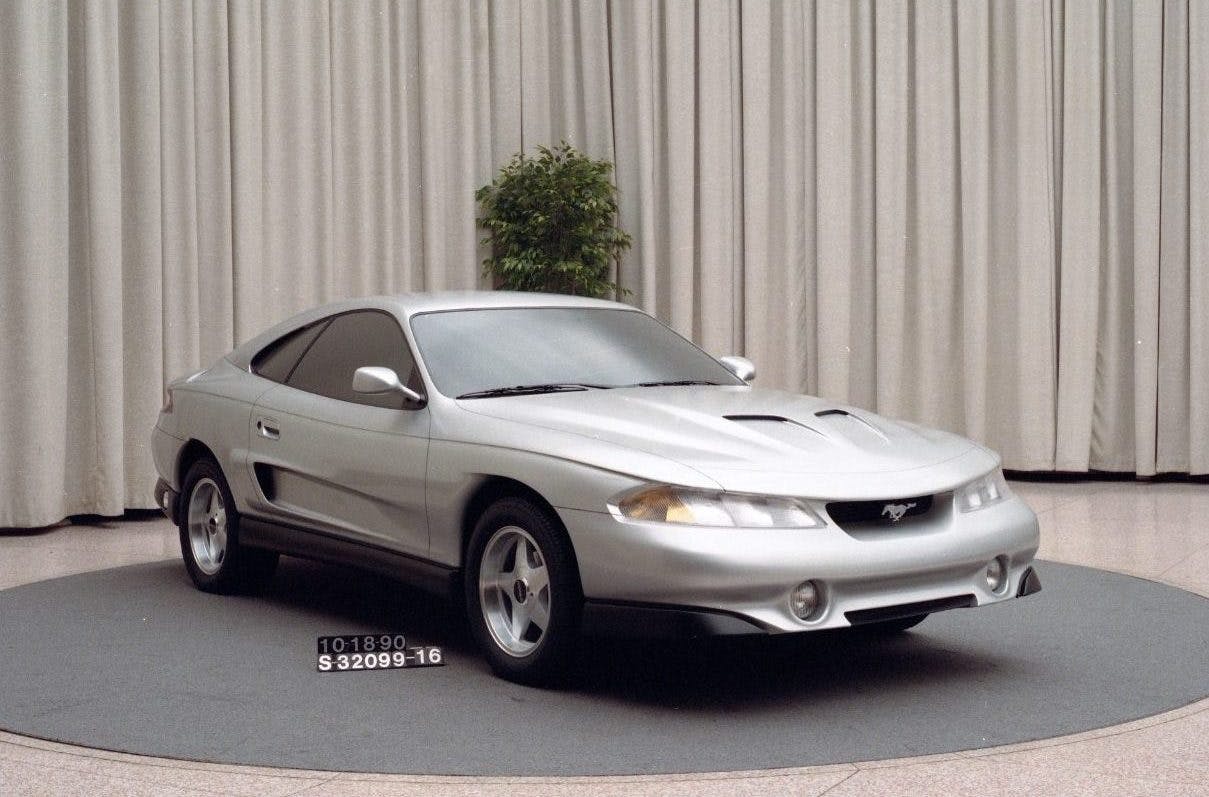
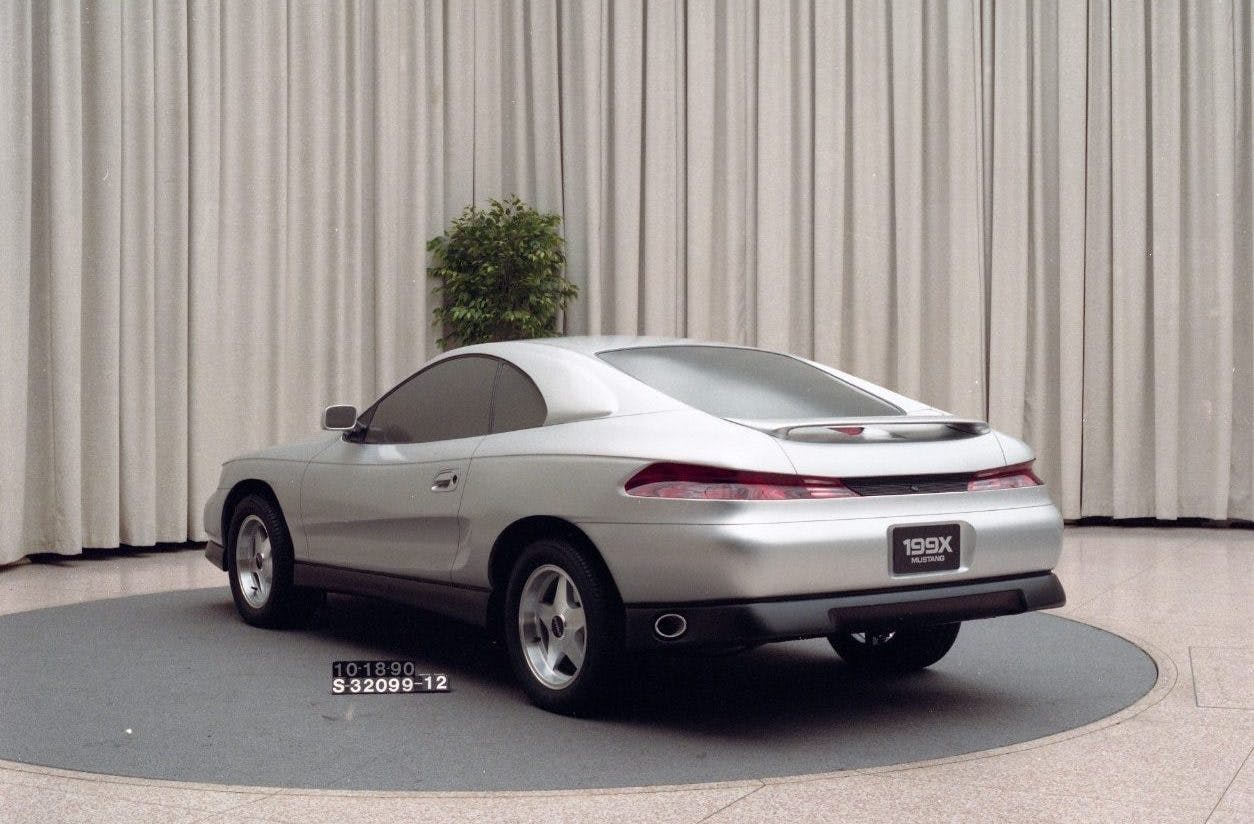
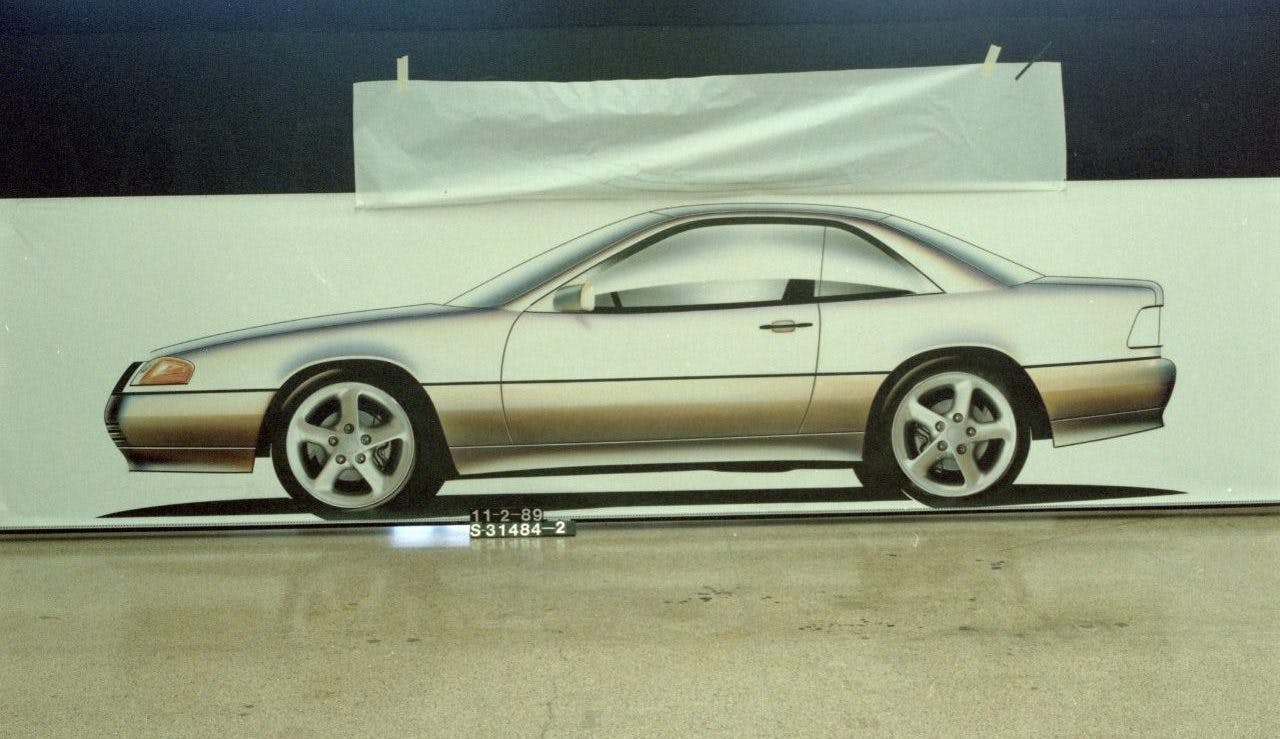
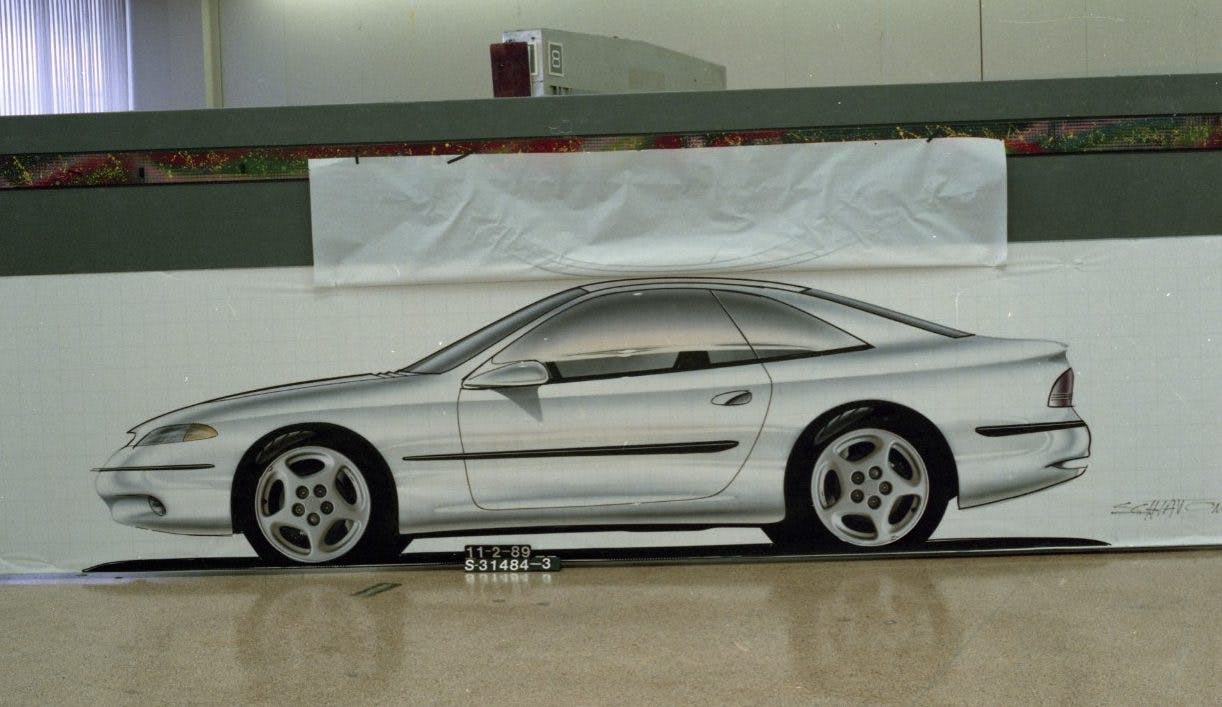
















While dating my late wife, I helped her in purchasing a 1993 Mazda MX-6 LS (V6 version). It was a sporty, fun and relatively quick little car, for it’s time. However, it was definitely not a Mustang replacement.
I don’t know about the MX-6 V6 not being a Mustang replacement, Mazda had plenty of problems with that engine, it might have been just as unreliable as the Mustang.
Hands down the wagon,…… but i would have gone with the Mustang II upgraded maverick.
I agree, absolutely hands down, the wagon version.
I own a near contemporary in the form of a Volvo 1800ES Sportwagon. It’s simply put, an attention getter.
Absolutely.
The sedan ! I appreciate the 4 doors
Agree on both! Wagons are cool (as a former ’55 Nomad owner) and I always wanted Nissan to build the sports-wagon version of the Z-Car, but it never got beyond the paper car stage, I guess. The 280Z 2+2 should have been a wagon; the flat-panel roof with the normal hatchback looks very awkward, but they sold it. Wick Humble
Some would say the during these styling exercises, Mustang stylists lost their way. Maybe. But when you revisit the heavily influenced European aspect of the company at the time, maybe not so hard to see why the then original Fox and the Fox 4 looked as they did. Jack Telnack, Chief of Design in Australia, then later Chief of Design for Ford Global, Michael Kranefus, head of SVO and others had spent much time in Europe at Ford’s various facilities there, and probably couldn’t help but be influenced. This was also during a time when Japanese and European brands were reshaping the American car landscape. Kranefus and his team specifically targeted the BMW owner with the SVO Mustang offering.
The wagon is magnificent! However, would it have sold in 1967/68 perhaps not so much.
I agree. The last thing we wanted as teens and young adults back then was a wagon. We love them now, but back then they were a hard sell, mainly because wagons still said, “Old man’s car” no matter how sporty.
The early Woodys where any thing but Old Man Cars
The wagon was a missed opportunity
it reminds me of the Pinto wagon (which is a compliment, not an insult!)
None would have made it just like the 4 door T-bird flopped in the late 60’s. Those later exercises that were jelly bean shaped are absolutely hideous.
Agree, they are not mustang and would have ruined the name, and the ev version isnot a mustang and should have been called something other than a mustang!
I SO agree with this! Why not call it something else?
Yep!!!
I know that in the 1970’s. while living on Long Island, I saw a Mustang Wagon on the road. It might have been a Hobo conversion. I’m a big wagon fan and have always wondered about that wagon.
The “Bruce Jenner” was “too soft”, so they tried the Rambo and the Swartzenegger.
I’ll be (hatch) back…
“OUCH”
Definitely the wagon, followed by the 4 door sedan for guys with a young family that also craved for a Mustang. The rest? I’m glad they never made it to production.
The 4-door really needed to lose the B-pillar to give a “clean” look to the side-window areas. And the back or the roofline really needed to be more similar to the Mustang Coupe roofline that went into production. That would have made a non-frumpy-looking 4-door an enthusiast could have enjoyed more.
Thank goodness Ford chose to produce the designs with the side scallops. Without them, they lose that unique Mustang personality.
It was the lack of Mustang legacy styling features that turned me off completely to the Fox body (gag!), but bought street cred to the Mustang II. E.g. side scallops, triptych taillights, horse emblem on the grill, horn button, gas cap, front fenders, etc.
I’ve said it before, the Fox body (gag!) was just a rebadged Mercury Capri.
Every single one of those pictures made me nauseous.
Amen to that.
Ditto!
the wagon
Love the wagon.
Had the 94 Probe GT. Not bad looking with the stock body kit. And quite quick with the 24v V6.
But not a Mustang.
–68 Mustang Owner
The wagon was a marvelous concept especially with those rear air inlets and could have been our American answer to the oh so British shooting brake cars of the time. Of course the limited demand torpedoed it from the start.